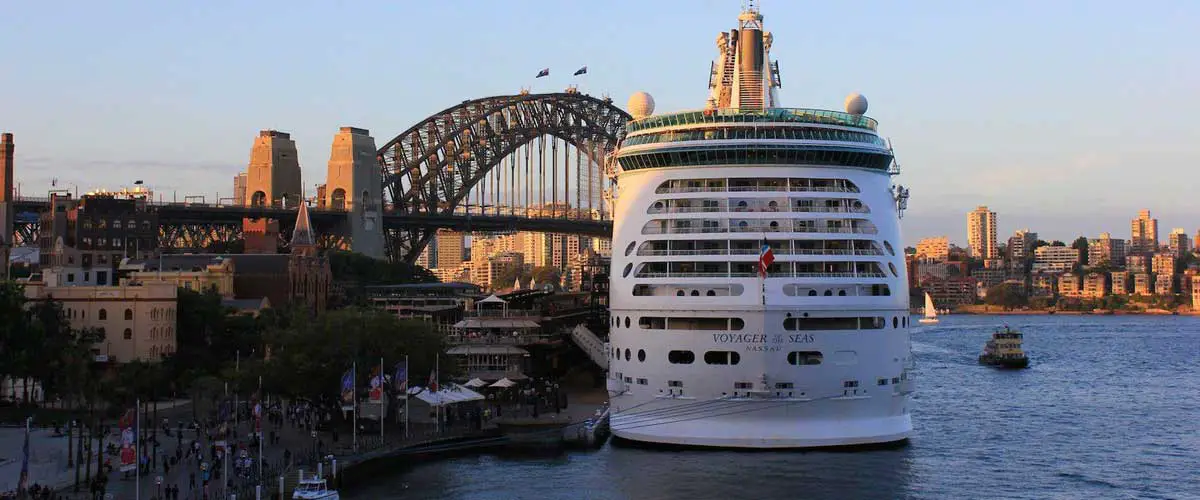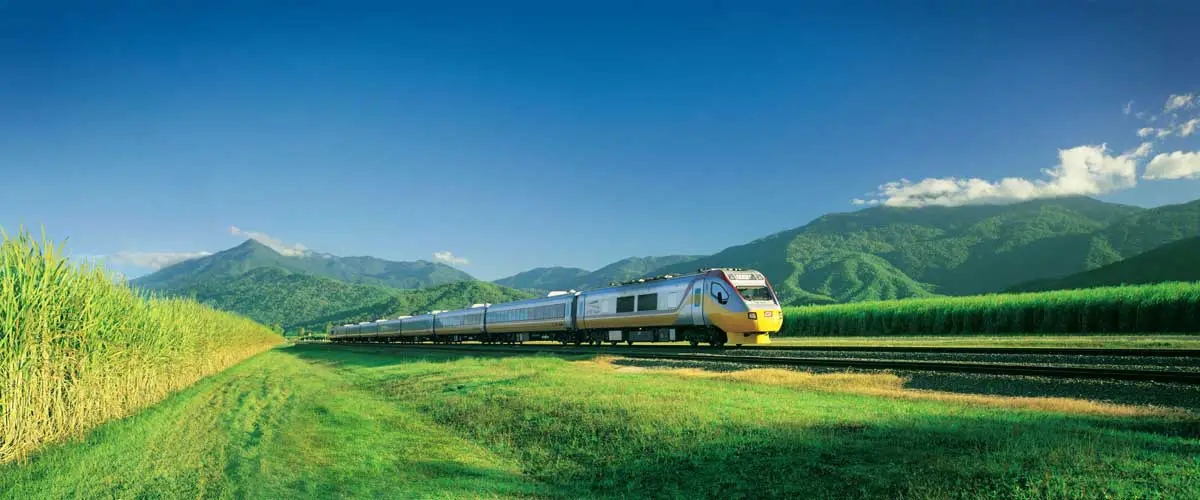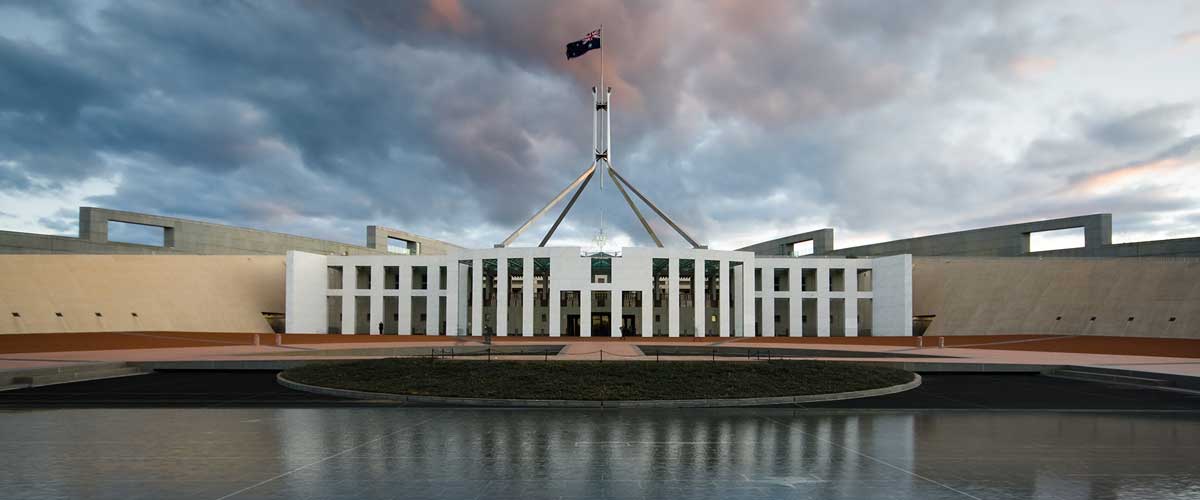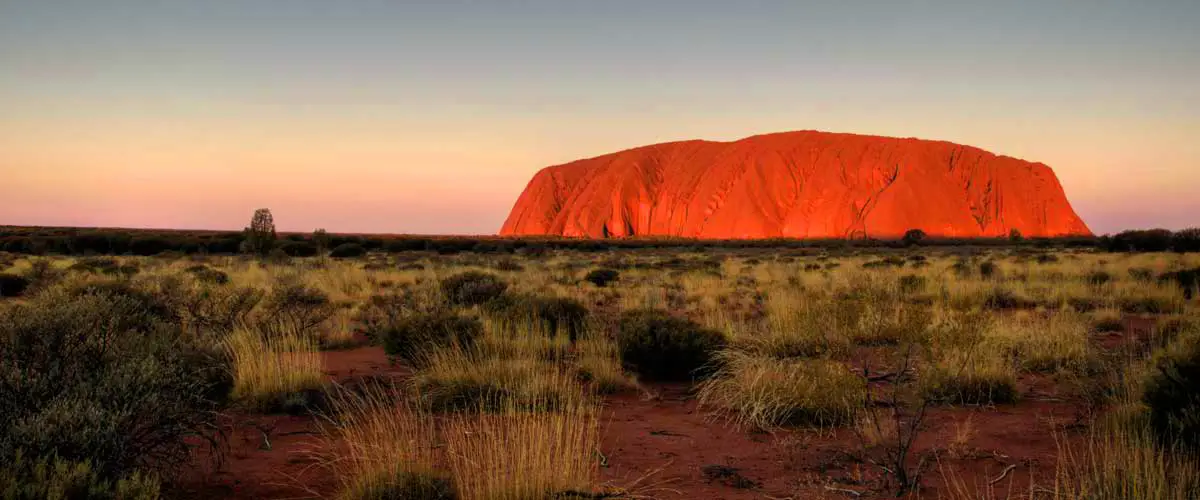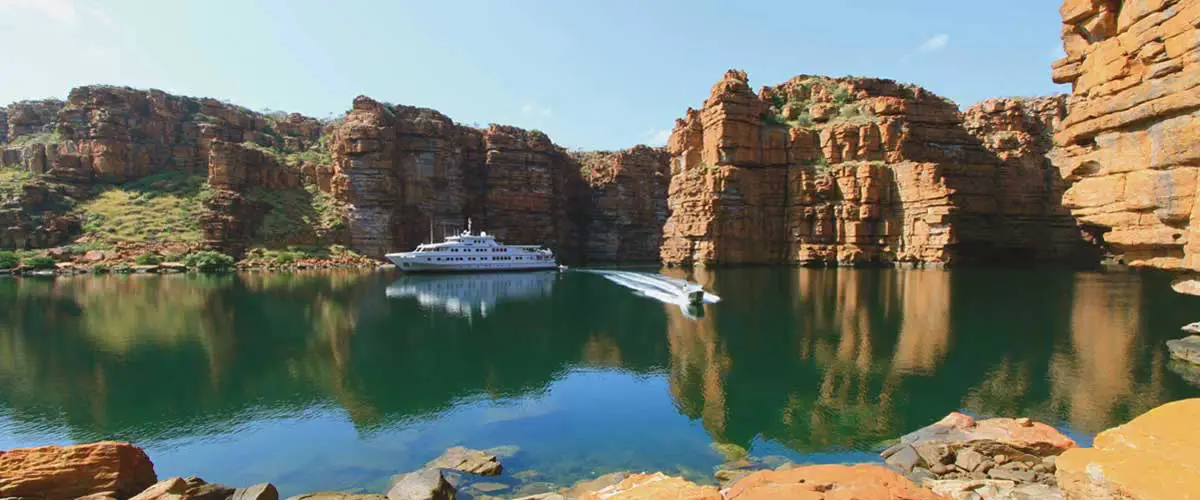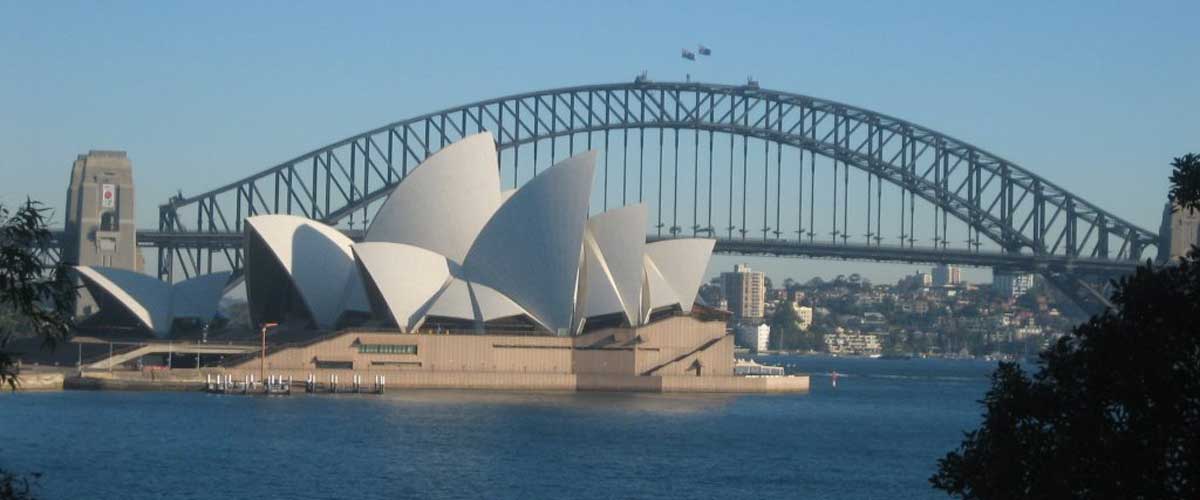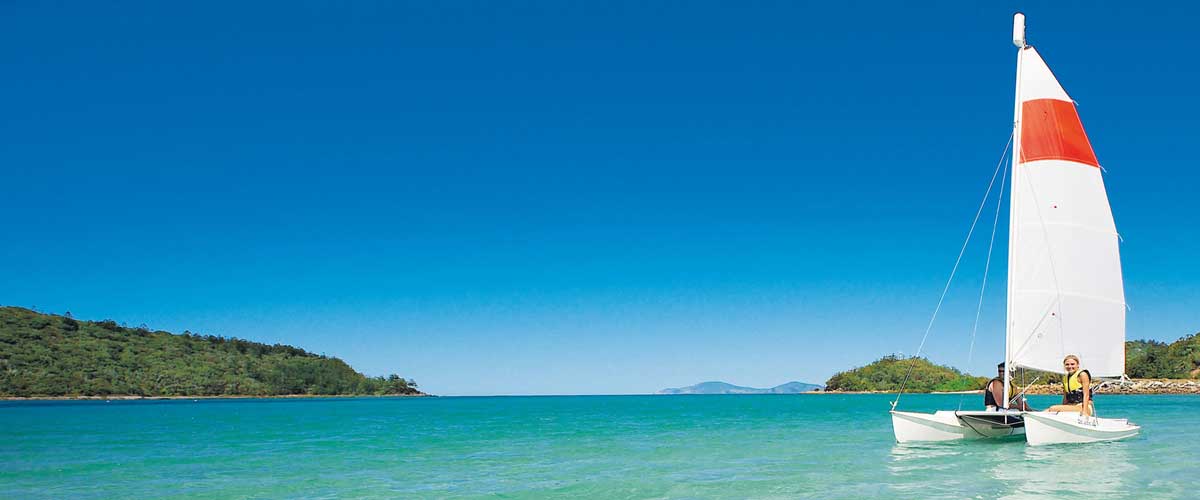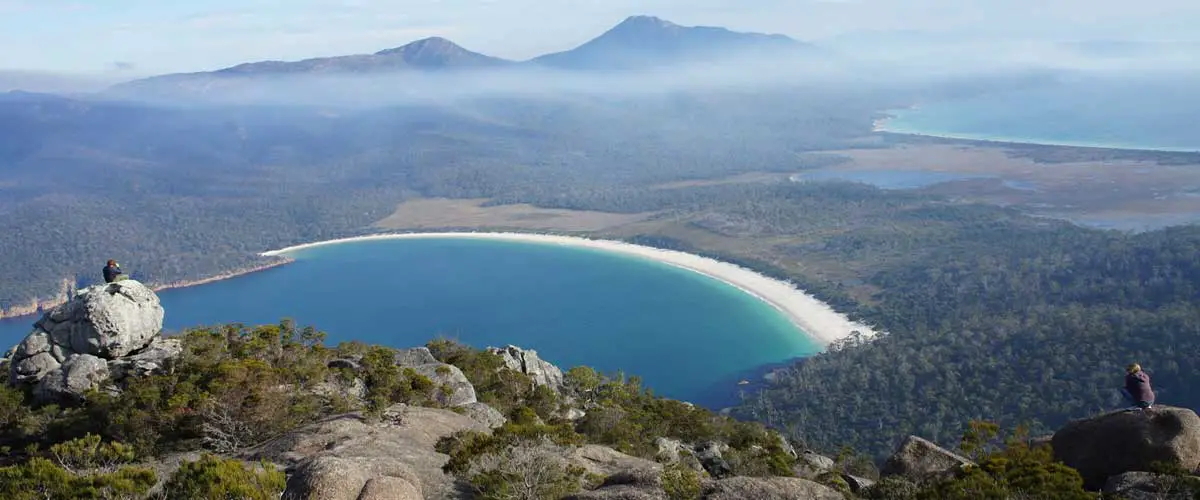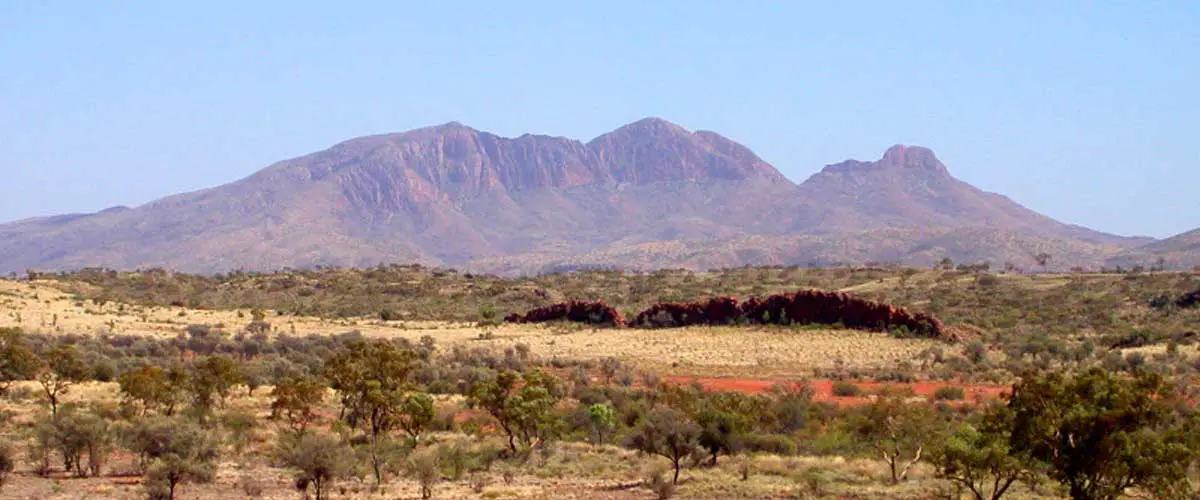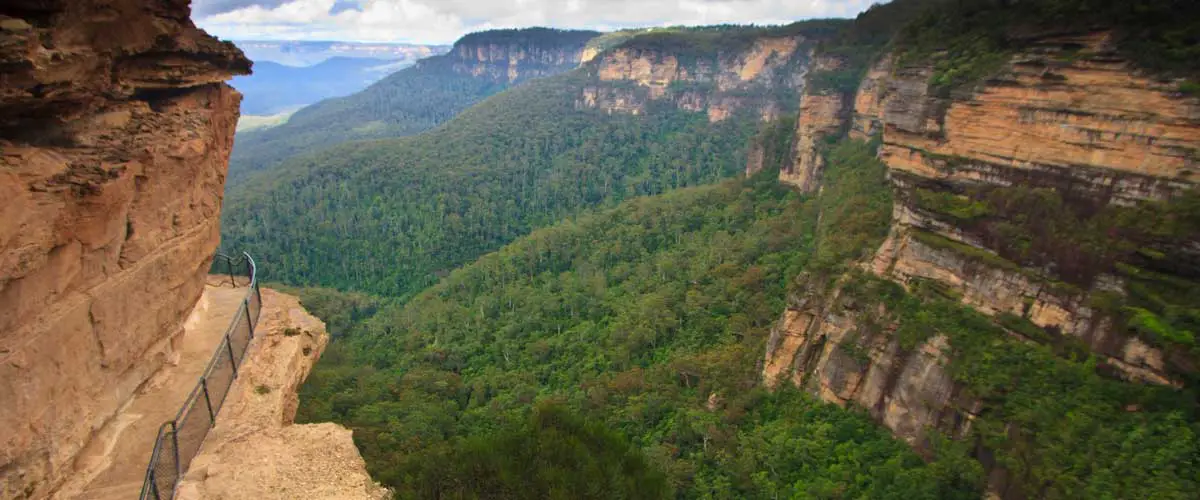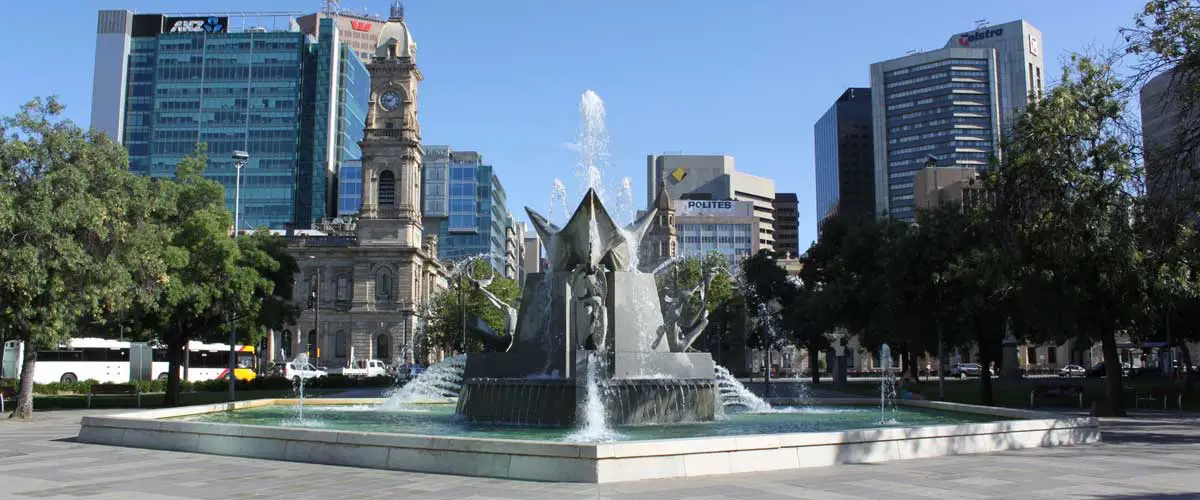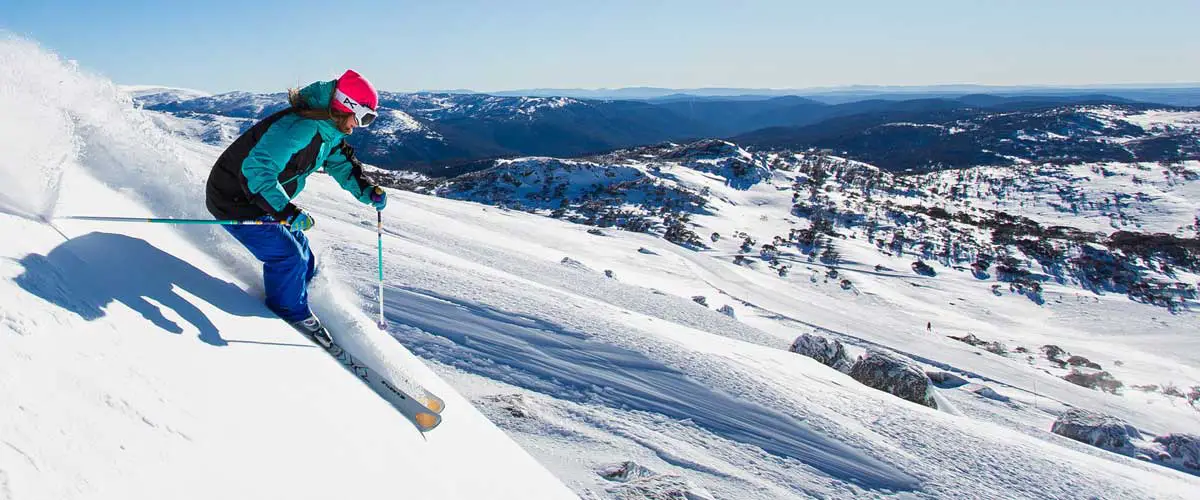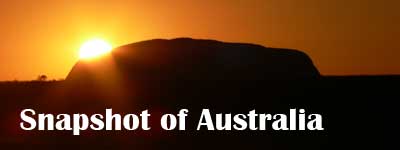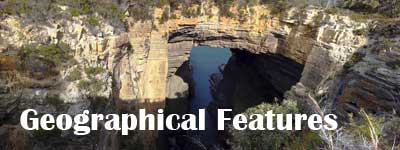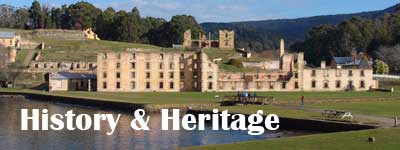






 Contact
Contact

Home | About Australia | Extremes
About Australia: Extremes
Australia is a country, and continent, surrounded by the Indian and Pacific oceans. Its major cities Sydney, Brisbane, Melbourne, Perth, Adelaide are coastal, but its capital, Canberra, is inland and nicknamed the “Bush Capital.” The country is known for its Sydney Opera House, Great Barrier Reef, the vast Outback (interior desert wilderness) and unique animal species including kangaroos and duck-billed platypuses.
Firsts
The first radio station in Australia was built near Pennant Hills, Sydney, in 1912. The first television station in Australia opened in 1956 as TCN Channel 9, Sydney.
The first television station in Australia opened in 1956 as TCN Channel 9, Sydney.
 Australias first country racing club was established in Wallabadah, NSW in 1852 and racing continues to this day with the townships famous New Years Day racing meeting.
Australias first country racing club was established in Wallabadah, NSW in 1852 and racing continues to this day with the townships famous New Years Day racing meeting.
 Among the convicts of the First Fleet was James Bloodsworth, an English brickmaker who made use of the brickmaking equipment brought on the voyage and became the colony’s first brick maker. He was largely responsible for the design and the erection of Australia’s first buildings.
Among the convicts of the First Fleet was James Bloodsworth, an English brickmaker who made use of the brickmaking equipment brought on the voyage and became the colony’s first brick maker. He was largely responsible for the design and the erection of Australia’s first buildings.
 During March 1788, the first emu encountered by Europeans was killed near the present site of Sydney’s Central Railway Station. It was measured at 2.25 metres high.
During March 1788, the first emu encountered by Europeans was killed near the present site of Sydney’s Central Railway Station. It was measured at 2.25 metres high.
 First Fleeter James Squire became the colony’s first brewer in 1790.
First Fleeter James Squire became the colony’s first brewer in 1790.
 Thomas Watling was the first professional artist to arrive in the colony (Royal Admiral, 1792) and was seconded to the Surgeon General, John White who was an amateur naturalist.
Thomas Watling was the first professional artist to arrive in the colony (Royal Admiral, 1792) and was seconded to the Surgeon General, John White who was an amateur naturalist.
 In 1798 Henry Kable, a First Fleet convict, opened a hotel called the Ramping Horse, from which he ran the first stage coach in Australia.
In 1798 Henry Kable, a First Fleet convict, opened a hotel called the Ramping Horse, from which he ran the first stage coach in Australia.
 Convict James Ruse has been called Australia’s first farmer. In 1789, Ruse was given 12 hectares of land near Parramatta, which he turned into the colony’s first proper farm, growing grain and vegetables. At that time he was the only self supporting farmer in the fledgling colony.
Convict James Ruse has been called Australia’s first farmer. In 1789, Ruse was given 12 hectares of land near Parramatta, which he turned into the colony’s first proper farm, growing grain and vegetables. At that time he was the only self supporting farmer in the fledgling colony.
 The first operation in the Southern Hemisphere to use anaesthetic was carried out in the 1840s at was is now Red Cross House in Launceston, Tasmania, that was a hospital in those days.
The first operation in the Southern Hemisphere to use anaesthetic was carried out in the 1840s at was is now Red Cross House in Launceston, Tasmania, that was a hospital in those days.
 Guy Menzies, the son of a Drummoyne doctor, was the first man to fly the Tasman Sea solo. Taking off from Mascot by the light of a car’s headlights on 7th January 1931, he crashlanded on the east coast of South Island, New Zealand about 12 hours later. Reaching the rank of squadron-leader in the RAF during World War II, he was posted as missing in November 1940.
Guy Menzies, the son of a Drummoyne doctor, was the first man to fly the Tasman Sea solo. Taking off from Mascot by the light of a car’s headlights on 7th January 1931, he crashlanded on the east coast of South Island, New Zealand about 12 hours later. Reaching the rank of squadron-leader in the RAF during World War II, he was posted as missing in November 1940.
 Australia’s first export was Eucalyptus oil, sent to England during November 1788 by Surgeon Denis Considen, who claimed to be the colony’s pharmaceutical pioneer.
Australia’s first export was Eucalyptus oil, sent to England during November 1788 by Surgeon Denis Considen, who claimed to be the colony’s pharmaceutical pioneer.
 Australia’s first person to be knighted was Sir Richard Dry, who was the first storekeeper at Paterson Barracks, Launceston, Tas.
Australia’s first person to be knighted was Sir Richard Dry, who was the first storekeeper at Paterson Barracks, Launceston, Tas.
 The first bunches of grapes to ripen in Australia were cut in Governor Phillip’s garden at Rose Hill (Parramatta, NSW) on 24th January 1791.
The first bunches of grapes to ripen in Australia were cut in Governor Phillip’s garden at Rose Hill (Parramatta, NSW) on 24th January 1791.
 The first orange tree in Australia was grown in Ryde in the early 1800s from a seed imported from Rio de Janeiro.
The first orange tree in Australia was grown in Ryde in the early 1800s from a seed imported from Rio de Janeiro.
 The world’s first pre-paid letter-sheets were issued by the New South Wales Post Office in 1838.
The world’s first pre-paid letter-sheets were issued by the New South Wales Post Office in 1838.
 Australia first theatrical performance took place on 4th June 1789. George Farquhar’s comedy The Recruiting Officer was performed by prisoners, in celebration of the King’s birthday, “in a mud hut fitted for the occasion”. Proceeds from the play were to go to the wife and family of a soldier who had drowned. Admittance was in kind, and rum, tobacco, wine, poultry and grain were taken at the door.
Australia first theatrical performance took place on 4th June 1789. George Farquhar’s comedy The Recruiting Officer was performed by prisoners, in celebration of the King’s birthday, “in a mud hut fitted for the occasion”. Proceeds from the play were to go to the wife and family of a soldier who had drowned. Admittance was in kind, and rum, tobacco, wine, poultry and grain were taken at the door.
 The world’s first movie projection was staged in Sydney NSW in November 1894, 12-months prior the Lumiere Brothers in Paris. Screened in a converted shop on Pitt Street, the 35 millimetre film ran at 40 images per second and was projected through a machine known as a kinescope. In the first five weeks of showing, there were 22,000 moviegoers, each paying a shilling each.
The world’s first movie projection was staged in Sydney NSW in November 1894, 12-months prior the Lumiere Brothers in Paris. Screened in a converted shop on Pitt Street, the 35 millimetre film ran at 40 images per second and was projected through a machine known as a kinescope. In the first five weeks of showing, there were 22,000 moviegoers, each paying a shilling each.
 The first recorded church service in Australia was held under a tree on 3rd February 1788 by the Reverend Richard Johnson, the First Fleet’s chaplain, who preached a sermon based on the text “What shall I render to the Lord for all his benefits toward me”. Johnson celebrated Holy Communion for the first time in the settlement on 17th February 1788. On the same day Lieut. Ralph Clark had a tooth removed, it being the first recorded dental work done in the colony.
The first recorded church service in Australia was held under a tree on 3rd February 1788 by the Reverend Richard Johnson, the First Fleet’s chaplain, who preached a sermon based on the text “What shall I render to the Lord for all his benefits toward me”. Johnson celebrated Holy Communion for the first time in the settlement on 17th February 1788. On the same day Lieut. Ralph Clark had a tooth removed, it being the first recorded dental work done in the colony.
 Australia’s first great female film star and the first woman film director was Lottie Lyell (1890-1925), who grew up in Balmain, NSW. Appearing in about 20 films, Lyell died from tuberculosis in 1925 at the young age of 35. Her greatest role was as Doreen, the factory girl in The Sentimental Bloke, which won critical acclaim in Australia and overseas.
Australia’s first great female film star and the first woman film director was Lottie Lyell (1890-1925), who grew up in Balmain, NSW. Appearing in about 20 films, Lyell died from tuberculosis in 1925 at the young age of 35. Her greatest role was as Doreen, the factory girl in The Sentimental Bloke, which won critical acclaim in Australia and overseas.
 On 26th June 1790 Richard Cheers became the first man convict to receive a conditional pardon. He arrived on the transport Surprise with 218 male convicts and was granted a pardon because he was seen as a hero for being the sole survivor of the wrecked storeship Guardian.
On 26th June 1790 Richard Cheers became the first man convict to receive a conditional pardon. He arrived on the transport Surprise with 218 male convicts and was granted a pardon because he was seen as a hero for being the sole survivor of the wrecked storeship Guardian.
 Australia’s first official census took placed during 1790. It recorded 2,545 inhabitants.
Australia’s first official census took placed during 1790. It recorded 2,545 inhabitants.
 The first sheep to die in Australia were five belonging to Major Robert Ross of the Sirius. They were killed when struck by lightning on 2nd February 1788.
The first sheep to die in Australia were five belonging to Major Robert Ross of the Sirius. They were killed when struck by lightning on 2nd February 1788.

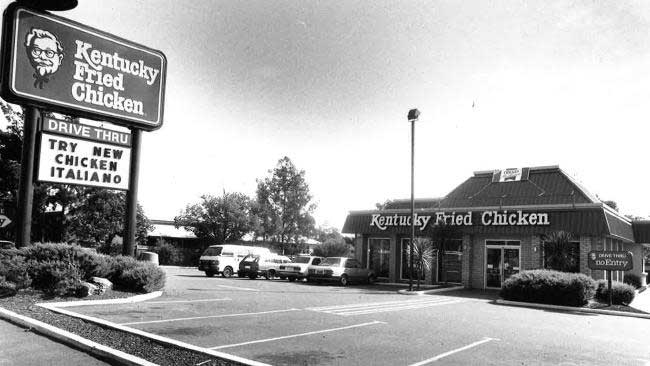
A young Canadian named Bob Lapointe started the fast food revolution in Australia in 1968 when he opened the first KFC (formerly Kentucky Fried Chicken) restaurant at Guildford in Sydney’s western suburbs. The first KFC restaurant was built on this site and opened on 27th April 1968, with a staff of 25. KFC now has more than 600 stores in Australia and New Zealand, which are company owned or franchised.
 William Redfern, a ship’s doctor after who the Sydney suburb of Redfern is named, could lay claim to being Australia’s first medical graduate. Tried for his involvement in a mutiny over bad pay and conditions in the British Navy, he was transported in 1801 on the Minorca to Norfolk Island, but was pardoned in 1803. Back in Sydney he wanted to become a doctor again, so he was tested by three other doctors and passed the test.
William Redfern, a ship’s doctor after who the Sydney suburb of Redfern is named, could lay claim to being Australia’s first medical graduate. Tried for his involvement in a mutiny over bad pay and conditions in the British Navy, he was transported in 1801 on the Minorca to Norfolk Island, but was pardoned in 1803. Back in Sydney he wanted to become a doctor again, so he was tested by three other doctors and passed the test.
 The first public protest in Australia occurred on 31st December 1791 when a crowd of convicts gathered around Governor Phillip’s house at Parramatta, NSW, to demand that rations be issued weekly as usual and not daily. Phillip refused and threatened to make examples of the leaders immediately, believing the protest was due to the influence of a handful of Irish convicts.
The first public protest in Australia occurred on 31st December 1791 when a crowd of convicts gathered around Governor Phillip’s house at Parramatta, NSW, to demand that rations be issued weekly as usual and not daily. Phillip refused and threatened to make examples of the leaders immediately, believing the protest was due to the influence of a handful of Irish convicts.
 The first strike in Australia occurred in 1827 when convict women at the female factory in Parramatta, NSW, withdrew their labour when their tea and sugar rations were stopped. They were victorious.
The first strike in Australia occurred in 1827 when convict women at the female factory in Parramatta, NSW, withdrew their labour when their tea and sugar rations were stopped. They were victorious.
 The first installation of a car radio in Australia occured in 1924. The car was built by Kellys Motors of Liverpool, NSW.
The first installation of a car radio in Australia occured in 1924. The car was built by Kellys Motors of Liverpool, NSW.
 The first person to appear before the Australian Criminal Court on a charge of drunkenness was convict Thomas Eccles, on 21st October, 1788. He was found guilty and his sentence, very mild for the times, required him to change his place of employment from “garden” to “brickfields”.
The first person to appear before the Australian Criminal Court on a charge of drunkenness was convict Thomas Eccles, on 21st October, 1788. He was found guilty and his sentence, very mild for the times, required him to change his place of employment from “garden” to “brickfields”.
 In 1915, Sydney became the first place in the world to appoint female police officers.
In 1915, Sydney became the first place in the world to appoint female police officers.
 John Goodman, the cook of British seafarer William Dampier’s ship, the Roebuck, died in August 1699 whilst on Dirk Hartog Island at Shark Bay, WA, making him the first British citizen to die and be buried on Australian soil.
John Goodman, the cook of British seafarer William Dampier’s ship, the Roebuck, died in August 1699 whilst on Dirk Hartog Island at Shark Bay, WA, making him the first British citizen to die and be buried on Australian soil.

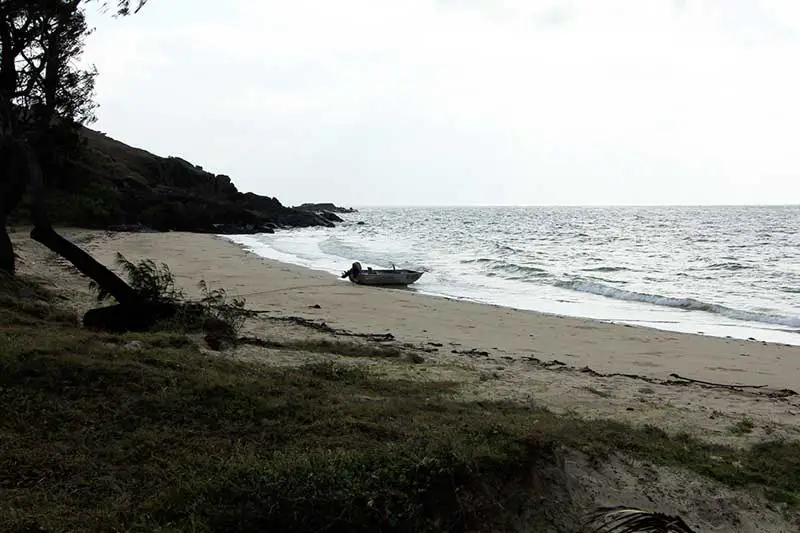
Cape Keerweer
The first Europeans known to have died and been buried on Australian soil were six Dutch sailors, they died near Cape Keerweer on the Gulf of Carpentaria in March 1606 at the hands of local Aborigines. Their names were not recorded. The story of this landing by crew of the Duyfken is documented from both written and Aboriginal oral history sources in The Mapoon Books, ed. Janine (Jan) Roberts 1975. The Aborigines recall that the Dutch built at Cape Keerweer a number of huts and put in a well, with Aboriginal help, prior to a conflict. This was, as far as is known, the first European settlement in Australia. The Aborigines recall that their ancestors then set fire to the boats on the beach and have recorded six Dutch graves. Captain Willem Janszoon decided to turn back afer losing the six men.
 Philip Schaffer is believed to have been the first European man to arrive as a free settler to Australia. Schaffer was granted 140 acres on the south side of the creek leading to Rose Hill (Parramatta, NSW) which he started to farm in March 1791.
Philip Schaffer is believed to have been the first European man to arrive as a free settler to Australia. Schaffer was granted 140 acres on the south side of the creek leading to Rose Hill (Parramatta, NSW) which he started to farm in March 1791.
 The first fine to be collected in an Australian court was 5 pound from convict William Bond. He was charged with buying a pair of trousers from John Kennedy, a private soldier in the Marines, for three and a half pounds of rice. As it was illegal for convicts to either buy or sell goods, Bond was found guilty and fined on 25th July 1791. Bond was a baker of Pitt Street, Sydney, and made Australia’s first damper.
The first fine to be collected in an Australian court was 5 pound from convict William Bond. He was charged with buying a pair of trousers from John Kennedy, a private soldier in the Marines, for three and a half pounds of rice. As it was illegal for convicts to either buy or sell goods, Bond was found guilty and fined on 25th July 1791. Bond was a baker of Pitt Street, Sydney, and made Australia’s first damper.

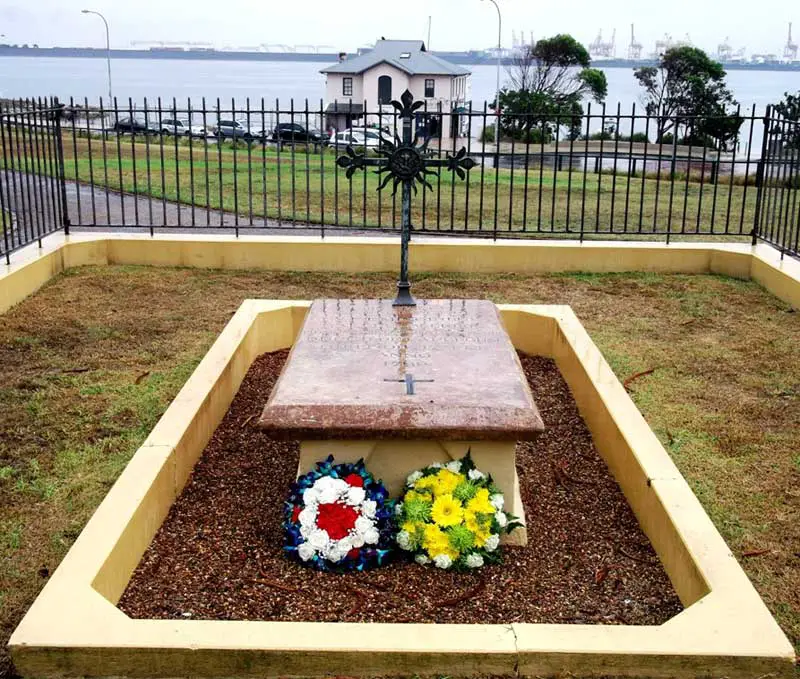
The grave of Claude-Francois Joseph Louis Receveur at La Perouse
The first Catholic Mass in Australia was held on the point of the La Perouse peninsula on Botany Bay, NSW, on 17th February 1788. It was attended by the crew of the french ships La Boussole and L’Astrolabe. Commanded by Jean Francois Galaup, Comte de la Perouse, the ships had sailed from Brest in 1785 on a four-year voyage of discovery at the direction of King Louis XIV. The ceremony was officiated by Abbe Jean-Andre Monges on the occasion of the death and burial of a Franciscan monk, Claude-Francois Joseph Louis Receveur, who sailed with the expedition as a naturalist, and died while at Botany Bay. After la Perouse and his ships left the bay a few weeks later, they were never seen again.
 Anniversary Day (now Australia Day) was celebrated for the first time on 26th January 1791.
Anniversary Day (now Australia Day) was celebrated for the first time on 26th January 1791.
 Australia’s first public holiday was the celebration of the birthday of King George 111 on 4th June, 1788.
Australia’s first public holiday was the celebration of the birthday of King George 111 on 4th June, 1788.
 Convicted thief Thomas Barrett was the first criminal to be sentenced to death in the fledgling colony of NSW on 27th February, 1788, barely a month after the arrival of the First Fleet.
Convicted thief Thomas Barrett was the first criminal to be sentenced to death in the fledgling colony of NSW on 27th February, 1788, barely a month after the arrival of the First Fleet.
 On 25th January 1788 a child was recorded to have been born to a Mrs Whittle between Botany Bay and Port Jackson, becoming the first European to be born in Australia. However the only person similarly named as part of the fleet’s company was a man, Edward Whitton.
On 25th January 1788 a child was recorded to have been born to a Mrs Whittle between Botany Bay and Port Jackson, becoming the first European to be born in Australia. However the only person similarly named as part of the fleet’s company was a man, Edward Whitton.
 Joshua Bentley was the first white child to be baptised in Australia. His mother was Mary Moulton, a servant girl, who was transported for shoplifting. On the transport ship Lady Penryn she had an affair with Joshua Bentley, a seaman, which resulted in the birth of a male child just out from the Cape of Good Hope on 16th November 1787. On arrival in Australia, the child was baptised aboard ship on 21st January 1788. James Thomas, son of convicts Samuel and Ann Thomas, was baptised on 3rd February, 1788, his being the first baptism in the colony on land. It is likely that he was the first white child to be born in the colony.
Joshua Bentley was the first white child to be baptised in Australia. His mother was Mary Moulton, a servant girl, who was transported for shoplifting. On the transport ship Lady Penryn she had an affair with Joshua Bentley, a seaman, which resulted in the birth of a male child just out from the Cape of Good Hope on 16th November 1787. On arrival in Australia, the child was baptised aboard ship on 21st January 1788. James Thomas, son of convicts Samuel and Ann Thomas, was baptised on 3rd February, 1788, his being the first baptism in the colony on land. It is likely that he was the first white child to be born in the colony.
 Australia’s first newspaper, the weekly Sydney and NSW Advertiser, was founded by Governor King on 5th March, 1803.
Australia’s first newspaper, the weekly Sydney and NSW Advertiser, was founded by Governor King on 5th March, 1803.

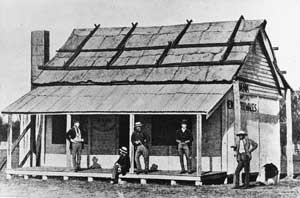
Australia’s first bank, the Bank of NSW (later Westpac), was opened by Governor Macquarie at premises rented from Mary Reiby in Macquarie Place, Sydney, on 8th April 1817.
 On 8th December 1888, J T Williams, a 22 year old watchmaker, made Australia’s first parachute descent when he jumped from a balloon 5,000 feet (1,700 metres) above the Sydney suburb of Homebush.
On 8th December 1888, J T Williams, a 22 year old watchmaker, made Australia’s first parachute descent when he jumped from a balloon 5,000 feet (1,700 metres) above the Sydney suburb of Homebush.
 On May 18th 1901, as the Royal Yacht sailed into Sydney Harbour, the first radio transmission was made in Australia.
On May 18th 1901, as the Royal Yacht sailed into Sydney Harbour, the first radio transmission was made in Australia.
 The first hearings of the Court of Criminal Jurisdiction (the Criminal Court) took place on 11th February, 1788. A number of convicts were charged with stealing. Thomas Hill was sentenced to be marooned on a rocky island in the harbour (Fort Denison) for one week on bread and water. Thomas Barrett, aged 17, was convicted and hanged the same evening for conspiring to rob the public stores. He was the first person (and the first juvenile offender) to be hanged in the colony. Joseph Hall and Henry Lovell, also sentenced to death, were reprieved and marooned on Pinchgut. The first woman sent to the gallows in NSW was convict, Judith Jones alias Ann Davis. She was executed on 23rd November 1789 after being convicted of breaking and entering a dwelling house and stealing a number of small items.
The first hearings of the Court of Criminal Jurisdiction (the Criminal Court) took place on 11th February, 1788. A number of convicts were charged with stealing. Thomas Hill was sentenced to be marooned on a rocky island in the harbour (Fort Denison) for one week on bread and water. Thomas Barrett, aged 17, was convicted and hanged the same evening for conspiring to rob the public stores. He was the first person (and the first juvenile offender) to be hanged in the colony. Joseph Hall and Henry Lovell, also sentenced to death, were reprieved and marooned on Pinchgut. The first woman sent to the gallows in NSW was convict, Judith Jones alias Ann Davis. She was executed on 23rd November 1789 after being convicted of breaking and entering a dwelling house and stealing a number of small items.
 Frank Mallon McElhone (1866 – 1925), a Sydney banker, claimed to be the first surf bather in Australia. In the 1880s, McElhone with a few others, entered the water at Bondi Beach. He was compelled to appear before the Central Police Court and was fined 1/- for bathing in a public place.
Frank Mallon McElhone (1866 – 1925), a Sydney banker, claimed to be the first surf bather in Australia. In the 1880s, McElhone with a few others, entered the water at Bondi Beach. He was compelled to appear before the Central Police Court and was fined 1/- for bathing in a public place.

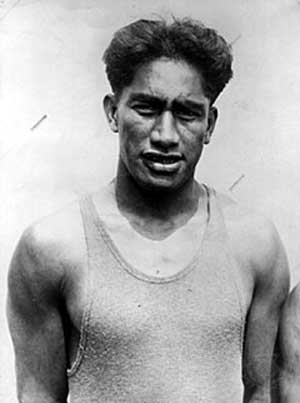
Duke Kahanamoku
Australia’s first surfboard was made in a Sydney timber yard from sugarpine in 1915. Visiting Hawaiian swimming champion Duke Kahanamoku had told some Australian swimmers about riding the waves on a wooden plank and drew a sketch of the board. When the shape was cut to size the Duke finished it by hand and then demonstrated his skills on the board at Freshwater beach, NSW. The board is on display at Freshwater Surf Lifesaving Club.
 On 23rd December, 1906, the first lifesaving reel was demonstrated at Bondi Beach, NSW. The reel was invented by the local lifesaving club captain, Lyster Ormsby.
On 23rd December, 1906, the first lifesaving reel was demonstrated at Bondi Beach, NSW. The reel was invented by the local lifesaving club captain, Lyster Ormsby.
 Australia’s first duel was fought between Surgeon John White and his assistant, William Balmain. Both were slightly wounded. The incident occurred on 12th August, 1788. Balmain served as third assistant surgeon to White on the Alexander, one of the ships of the First Fleet. Balmain was granted land in the area which bears his name in 1800 but never lived there.
Australia’s first duel was fought between Surgeon John White and his assistant, William Balmain. Both were slightly wounded. The incident occurred on 12th August, 1788. Balmain served as third assistant surgeon to White on the Alexander, one of the ships of the First Fleet. Balmain was granted land in the area which bears his name in 1800 but never lived there.
 Darrell Lea Chocolates were first sold from a shop at Manly Beach, NSW, in the 1920s by Harry and Esther Lea.
Darrell Lea Chocolates were first sold from a shop at Manly Beach, NSW, in the 1920s by Harry and Esther Lea.
 Listowel Downs, near Adavale, Qld, was the site of Australia’s first recored opal find (1872). The gems run in a belt from the NSW border to the north of Winton.
Listowel Downs, near Adavale, Qld, was the site of Australia’s first recored opal find (1872). The gems run in a belt from the NSW border to the north of Winton.
 The first Sydney to Hobart Yacht Race was held in 1945. The winner was Rani, which made the distance in 6 days 14 hours 22 minutes.
The first Sydney to Hobart Yacht Race was held in 1945. The winner was Rani, which made the distance in 6 days 14 hours 22 minutes.
 The first localy built vesel in Australia was launched in October 1789 and called the Rose Hill Packet. Used in the Paramatta River trade for cargo and passengers, this 10 tonne vessel was also the first Sydney ferry service.
The first localy built vesel in Australia was launched in October 1789 and called the Rose Hill Packet. Used in the Paramatta River trade for cargo and passengers, this 10 tonne vessel was also the first Sydney ferry service.
 The first American ship to visit Australia was the brigantine Philadelphia, which arrived in Sydney on the 1st November 1792 from Philadelhpia via the Cape of Good Hope. American vessels including many whalers were common early visitors to Australian ports.
The first American ship to visit Australia was the brigantine Philadelphia, which arrived in Sydney on the 1st November 1792 from Philadelhpia via the Cape of Good Hope. American vessels including many whalers were common early visitors to Australian ports.
 The first steamship built in Australia was the Surprise, built at Mr Millard’s Slip at Neutral Bay in Sydney Harbour in 1831. A vessel of 26 metres, it made it’s first trip on the 2nd June 1831 and so was the second steamship to operate in Australian waters, just being beaten by the Sophia Jane.
The first steamship built in Australia was the Surprise, built at Mr Millard’s Slip at Neutral Bay in Sydney Harbour in 1831. A vessel of 26 metres, it made it’s first trip on the 2nd June 1831 and so was the second steamship to operate in Australian waters, just being beaten by the Sophia Jane.

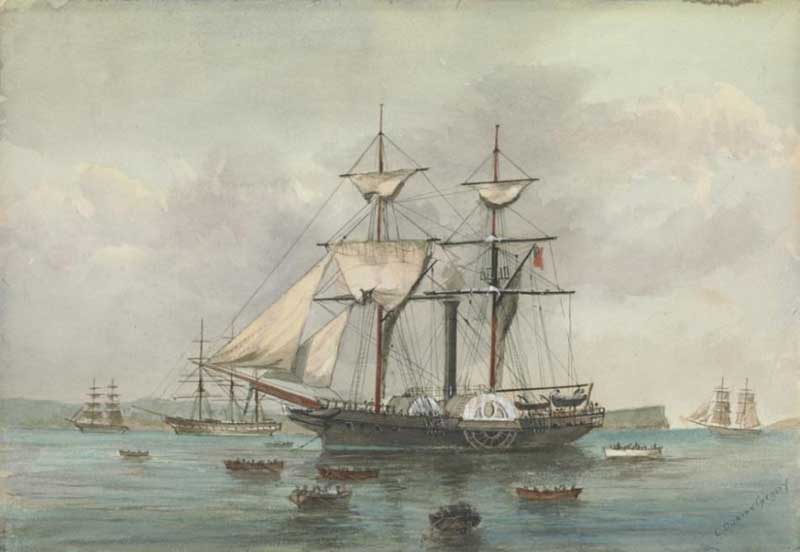
P.S. Sophie Jane – from a painting by Dickson Gregory, image No.; 2805501, courtesy State Library of Victoria
Sophie Jane was the first steamship to operate in Australian waters. The paddle wheeler arrived in Sydney on the 14th May 1831 under sail and commenced work in the coastal trade from Sydney-Newcastle.
 The first Australians to circumnavigate the world was yachtsman Harold Nossiter with his sons Dick. They circumnavigated the globe in their yacht Sirius, completing their voyage on the 20th May 1937.
The first Australians to circumnavigate the world was yachtsman Harold Nossiter with his sons Dick. They circumnavigated the globe in their yacht Sirius, completing their voyage on the 20th May 1937.
 The first telephone call in Australia was made in Tasmania, between Launceston and Campbell Town in 1874.
The first telephone call in Australia was made in Tasmania, between Launceston and Campbell Town in 1874.
 The first parking meters in Australia were installed in Collins Street, Hobart in 1955.
The first parking meters in Australia were installed in Collins Street, Hobart in 1955.
 Tasmania was the first state to introduce ground-breaking relationship legislation (Relationships Act 2003), providing legal rights for de factos and same-sex couples in “significant relationships”.
Tasmania was the first state to introduce ground-breaking relationship legislation (Relationships Act 2003), providing legal rights for de factos and same-sex couples in “significant relationships”.
 Australia’s first legal casino was opened at Wrest Point, a suburb of Hobart, in 1973.
Australia’s first legal casino was opened at Wrest Point, a suburb of Hobart, in 1973.
 Tasmania was the first Australian state to introduce a compulsory state education system in 1868.
Tasmania was the first Australian state to introduce a compulsory state education system in 1868.
 The Tasmanian town of Coles Bay, on the Freycinet Peninsula, was the first town in Australia to ban plastic bags – in April 2003.
The Tasmanian town of Coles Bay, on the Freycinet Peninsula, was the first town in Australia to ban plastic bags – in April 2003.
 Tasmanian George Adams established the first Tattersalls Lottery in Hobart, 1896. This lottery has now evolved into Australia’s Tattslotto system.
Tasmanian George Adams established the first Tattersalls Lottery in Hobart, 1896. This lottery has now evolved into Australia’s Tattslotto system.

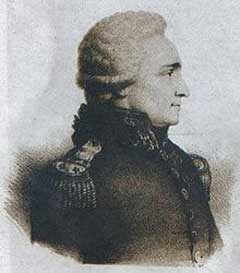
Bruni d’Entrecasteaux
It is often stated that British navigator Matthew Flinders was the first person to circumnavigate Australia, but this is not so. The first to achieve that exploratory milestone was Frenchman Bruni d’Entrecasteaux, when he visited Australia’s shores in 1792 and 1793, some three years before Flinders made his visit. It must be said, however, that d’Entrecasteaux took the “long way round”, and did not follow the northern Australian coast via the Gulf of Carpentaria, but passed north of New Guinea.
Though circumnavigating Australia was one of the tasks given to Flinders in 1796, he never achieved it. Flinders’ commission was in fact completed by Phillip Parker King, sailing aboard HMS Mermaid in 1817-1822, who did circumnavigate Australia, mapping the coast as he went.
Most Distant
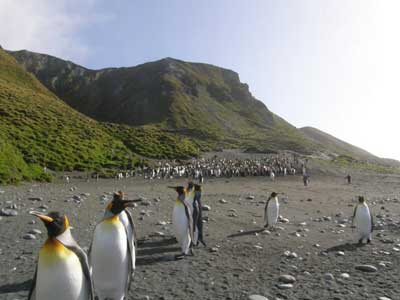
Macquarie Island is Australia’s most distant possession. Located in the Southern Ocean at a Latitude of 54°30′ South, longitude 158°57′ East, Macquarie Island is actually 200km closer to the Antarctic continent than its parent state of Tasmania, which lies 1500 kilometres north-west. Measuring an area of 128 square kilometers, Macquarie Island is 34 kilometers long by just 5 kilometers at its widest point.
Longest
Between the towns of Ooldia and Nurina in Western Australia is the world’s longest straight stretch of railway. It extends for 478.4 kilometres. The Great Barrier Reef, Qld, is the longest coral reef in the world, extending over 2,012.5 kilometres.
The Great Barrier Reef, Qld, is the longest coral reef in the world, extending over 2,012.5 kilometres.
 Marble Bar, WA, recorded the longest period of extreme heat of above 37.7 C. for 160 days from October 1923 to April 1924.
Marble Bar, WA, recorded the longest period of extreme heat of above 37.7 C. for 160 days from October 1923 to April 1924.
 WA has the longest coastline of an it Australian state. It measures 20,781 kilometres.
WA has the longest coastline of an it Australian state. It measures 20,781 kilometres.
 At 790 km, the cliffs of the Great Australian Bight – Wylie Scarp, Baxter Cliffs, Hampton Tableland and Bunda Cliffs – are the longest in Australia.
At 790 km, the cliffs of the Great Australian Bight – Wylie Scarp, Baxter Cliffs, Hampton Tableland and Bunda Cliffs – are the longest in Australia.
 At 2,520 km, Australia’s longest river is the Murray River.
At 2,520 km, Australia’s longest river is the Murray River.
 Australia’s longest cave system is the Exit Caves in Tasmania. They have a length of 17,000 metres.
Australia’s longest cave system is the Exit Caves in Tasmania. They have a length of 17,000 metres.

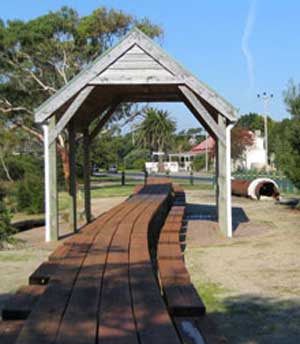
On the banks of the Tarwin River near the town of Tarwin, Vic, is what is believed to be the longest barbeque table in Australia. It seats 120 people. The longest single-span chairlift in the world is across Launceston’s Cataract Gorge, Tas.
 At 135 metres, the Empress of Australia was the world’s longest roll on roll off (ro-ro) ferry when it was launched in January 1965. Built at the Cockatoo Island Dockyard in Sydney, the Tasmania-Mainland ferry had a gross tonage of 12,037 tonnes. The Empress was replaced by the Abel Tasman. It was sold and renamed Royal Pacific. and sank in the Malacca Strait, in 1991 after colliding with a Taiwanese fishing vessel.
At 135 metres, the Empress of Australia was the world’s longest roll on roll off (ro-ro) ferry when it was launched in January 1965. Built at the Cockatoo Island Dockyard in Sydney, the Tasmania-Mainland ferry had a gross tonage of 12,037 tonnes. The Empress was replaced by the Abel Tasman. It was sold and renamed Royal Pacific. and sank in the Malacca Strait, in 1991 after colliding with a Taiwanese fishing vessel.

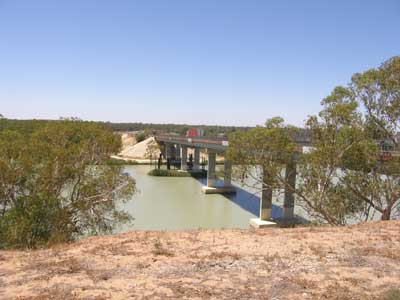
Murray River at Paringa, SA
Australia’s Longest Rivers
The Murray River is the longest river in Australia at 2520km, combining with the Darling and Upper Darling Rivers to form the Murray-Darling basin. The Murray Darling extends over 15% of the continent, and serving 4 States and the ACT with water. The Murray also supports about 1/3 of Australia’s agricultural production, supports 50% of Australia’s sheep and croplands, and 25% of beef and dairy herds, contains about 62% of the country’s irrigated land and supplies 50% of South Australia’s water. Lengths shown are approximate.
River Murray (NSW/SA): 2,375 km
Murrumbidgee River (NSW/ACT): 1,485 km
Darling River (from River Murray to Culgoa River) (NSW): 1,472 km
Lachlan River (NSW): 1,339 km
Coopers Creek (Qld/SA): 1,113 km
Flinders River (Qld): 1,004 km
Diamantina River (Qld/SA): 941 km
Longest Rivers: by state/territory
Although the River Murray forms much of the border separating New South Wales and Victoria, it is not Victoria’s longest river because the New South Wales border is delineated by the river’s southern bank rather than by the middle of the river. The only section of the river considered within Victoria is a stretch of approximately 11 kilometres where it separates Victoria and South Australia. At this point, the middle of the river forms the border. Lengths shown are approximate and show the length of that river in that particular state or territory.
NSW: River Murray, 1,721 km
Qld: Flinders River, 1,004 km
WA: Gascoyne River, 834 km
SA: River Murray: 683 km
Vic: Goulburn River 683 km
NT: Victoria River: 510 km
Tas: South Esk River: 245 km
ACT: Murrumbidgee River, 59 km
Highest
The highest recorded temperature of 53.1 C was at Cloncurry, Qld, on 16 January 1889. Marble Bar, WA, has the highest monthly average temperature of any locality in Australia. During the summer months, the town averages 41 degrees celsius.
Marble Bar, WA, has the highest monthly average temperature of any locality in Australia. During the summer months, the town averages 41 degrees celsius.
 The highest rainfall ever recorded in a 24 hour period in an Australian town was at Crohamhurst in South East Qld on 3rd february 1893. On that day 907 mm of rain fell. Ballenden Ker, Qld’s highest mountain, holds the country’s record – 960 mm (38 inches) – for the most rainfall ever recorded in a 24-hour period.
The highest rainfall ever recorded in a 24 hour period in an Australian town was at Crohamhurst in South East Qld on 3rd february 1893. On that day 907 mm of rain fell. Ballenden Ker, Qld’s highest mountain, holds the country’s record – 960 mm (38 inches) – for the most rainfall ever recorded in a 24-hour period.The highest 24-hour rainfall for the other states is:
NSW – Dorrign, 809 mm, 21st February 1954
WA – Broome (Kilto), 635 mm, 5th December 1970
NT – Roper Valley Station, 545 mm, 15th April 1963
Tas – Germantown, 508 mm, 22nd March 1974
Vic – Tanybryn, 375 mm, 22nd March 1983
SA – Motpena Station, 273 mm, 14th March 1989
ACT – Cotter River, 181 mm, 27th May 1925
 The highest recorded rainfall in a 12 hour period was 707 mm (28 inches) at Wongawilli, near Wollongong, NSW on 18th February 1984. The mean annual precipitation for the area is 1194 mm.
The highest recorded rainfall in a 12 hour period was 707 mm (28 inches) at Wongawilli, near Wollongong, NSW on 18th February 1984. The mean annual precipitation for the area is 1194 mm.
 The highest annual rainfall ever recorded in Australia was at Bellenden Ker in Northern Qld. The summit of Bellenden Ker, south-west of Cairns, recorded 12,461 millimetres of rain in 2000, breaking its own 1999 record of 11,852 mm by 609mm. The wettest month of 2000 at Bellenden Ker was February when 3376 mm was recorded. Of that, 1050 mm fell in three days during the passage of Tropical Cyclone Steve on February 25-28. This total fell short of Bellenden Ker’s (and Australia’s) monthly record of 5387 mm set in January 1979. Bellenden Ker – 1555 metres above sea level – is the wettest meteorological station in Australia. It averages 8,312 mm (328 inches) a year, about double that of towns in the region with high rainfall such as Babinda and Tully, which are near sea level.
The highest annual rainfall ever recorded in Australia was at Bellenden Ker in Northern Qld. The summit of Bellenden Ker, south-west of Cairns, recorded 12,461 millimetres of rain in 2000, breaking its own 1999 record of 11,852 mm by 609mm. The wettest month of 2000 at Bellenden Ker was February when 3376 mm was recorded. Of that, 1050 mm fell in three days during the passage of Tropical Cyclone Steve on February 25-28. This total fell short of Bellenden Ker’s (and Australia’s) monthly record of 5387 mm set in January 1979. Bellenden Ker – 1555 metres above sea level – is the wettest meteorological station in Australia. It averages 8,312 mm (328 inches) a year, about double that of towns in the region with high rainfall such as Babinda and Tully, which are near sea level.
 Lake Margaret Dam in Western Tasmania has the most frequent rainfall in Australia. It rains on an average of 250 days per year. Its highest accumulated rainfall recorded in a calendar year is 4,504 mm in 1948.
Lake Margaret Dam in Western Tasmania has the most frequent rainfall in Australia. It rains on an average of 250 days per year. Its highest accumulated rainfall recorded in a calendar year is 4,504 mm in 1948.
 The highest number of rainy days ever recorded in a year was 314 at Waratah in Tasmania’s North-west in 1955.
The highest number of rainy days ever recorded in a year was 314 at Waratah in Tasmania’s North-west in 1955.
 The highest town in Australia is Perisher Valley in the New South Wales snow country. It is located at 1,740 metres above sea level. The highest towns in the other states are:
VIC: Hotham Heights 1,700 metres above sea level
TAS: Reynolds Neck 1,100 metres above sea level
QLD: Ravenshoe 930 metres above sea level
WA: Tom Price 750 metres above sea level
NT: Areyonga 700 metres above sea level
SA: Amata 700 metres above sea level
ACT: Canberra 660 metres above sea level
The highest town in Australia is Perisher Valley in the New South Wales snow country. It is located at 1,740 metres above sea level. The highest towns in the other states are:
VIC: Hotham Heights 1,700 metres above sea level
TAS: Reynolds Neck 1,100 metres above sea level
QLD: Ravenshoe 930 metres above sea level
WA: Tom Price 750 metres above sea level
NT: Areyonga 700 metres above sea level
SA: Amata 700 metres above sea level
ACT: Canberra 660 metres above sea level
 Heard Island is home Australia’s only active volcano, Big Ben, which is also Australia’s highest mountain. The highest mountain in on mainland Australia is Mt. Kosciuszko (2228 metres). The highest mountains in each state are:
Heard Island is home Australia’s only active volcano, Big Ben, which is also Australia’s highest mountain. The highest mountain in on mainland Australia is Mt. Kosciuszko (2228 metres). The highest mountains in each state are:NSW: Mt. Kosciuszko 2228 metres
VIC: Mt. Bogong 1986 metres
ACT: Bimberi Peak 1912 metres
QLD: Bartle Frere (S. Peak) 1622 metres
TAS: Mt. Ossa 1617 metres
NT: Mt. Zeil 1531 metres
SA: Mt. Woodroffe 1435 metres
WA: Mt. Meharry 1253 metres

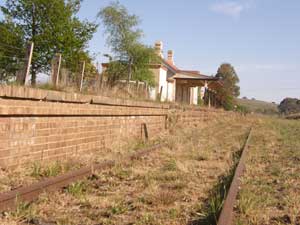
Ben Lomond railway station on the former Great Northern Railway, NSW, was the highest point on the line and the highest point attained by any Australian railway. The railway station, currently not in use, is 1,363 metres above sea level.
Lowest
The lowest temperature ever recorded in Australia was minus 23 degrees celsius at Charlotte Pass, NSW, on 18th June 1994. The lowest surface point in Australia is Lake Eyre, which is 16 metres below sea level.
The lowest surface point in Australia is Lake Eyre, which is 16 metres below sea level.
 Australia’s deepest cave which is the lowest underground point, is Anne-A-Kananda at Mt Anne, Tas. It goes 373 metres below surface level.
Australia’s deepest cave which is the lowest underground point, is Anne-A-Kananda at Mt Anne, Tas. It goes 373 metres below surface level.
Largest
Australia is the world’s largest inhabited island. The world’s largest electorate (2,255,278 square kilometres) is Kalgoorlie, WA.
The world’s largest electorate (2,255,278 square kilometres) is Kalgoorlie, WA.
 Australia is the largest continent occupied by one nation and is the least populated.
Australia is the largest continent occupied by one nation and is the least populated.
 Wolf Creek, WA, has the largest meteorite crater in Australia, measuring 853.44 metres in diameter and 61 metres deep.
Wolf Creek, WA, has the largest meteorite crater in Australia, measuring 853.44 metres in diameter and 61 metres deep.
 Australia is the largest exporter of camels in the world. 10 000 camels a year make the trip each year, earning the country $2 million in export.
Australia is the largest exporter of camels in the world. 10 000 camels a year make the trip each year, earning the country $2 million in export.
 Australia’s largest state is WA. It has an area of 2,529,875 square kilometres.
Australia’s largest state is WA. It has an area of 2,529,875 square kilometres.
 Qld has the largest coastal waters of any state. They total 121,994 square kilometres.
Qld has the largest coastal waters of any state. They total 121,994 square kilometres.
 Excluding Tasmania, Australia’s largest island is Melville Island, NT. It has an area of 5,786 square kilometres.
Excluding Tasmania, Australia’s largest island is Melville Island, NT. It has an area of 5,786 square kilometres.
 Australia’s largest desert is the Great Victoria Desert. It covers a vast 648,500 sq. km.
Australia’s largest desert is the Great Victoria Desert. It covers a vast 648,500 sq. km.
 WA has 3,747 islands within its borders, the largest number of islands of any state of Australia.
WA has 3,747 islands within its borders, the largest number of islands of any state of Australia.

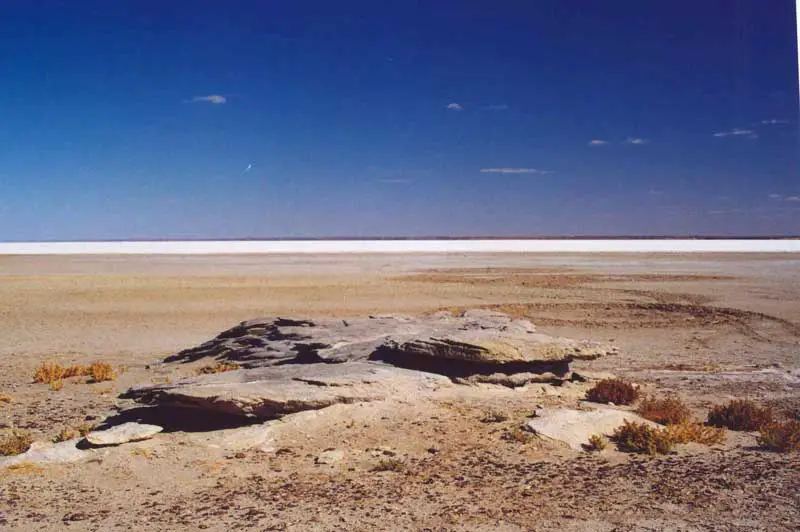
Australia’s largest water body is Lake Eyre, SA. Though rarely full, this salt lake has an area of 9,500 square kilometres.
 Australia’s largest man made lake is Lake Gordon in western Tasmania. It has a capacity of 12,450 cubic metres.
Australia’s largest man made lake is Lake Gordon in western Tasmania. It has a capacity of 12,450 cubic metres.
 The largest desert in Australia is the Great Victoria Desert. With an area of 348,750 square kilometres, it covers 4.5% of the Australian continent.
The largest desert in Australia is the Great Victoria Desert. With an area of 348,750 square kilometres, it covers 4.5% of the Australian continent.
 The 6.5 million hectare Heard Island and McDonald Islands Marine Reserve is the world’s largest marine reserve. Situated 4500 kilometres south-west of the Australian mainland and 1000 kilometres North of Antarctica, it falls within Australia’s 320 km Exclusive Economic Zone surrounding Heard and McDonald Islands.
The 6.5 million hectare Heard Island and McDonald Islands Marine Reserve is the world’s largest marine reserve. Situated 4500 kilometres south-west of the Australian mainland and 1000 kilometres North of Antarctica, it falls within Australia’s 320 km Exclusive Economic Zone surrounding Heard and McDonald Islands.
Shortest
The shortest street in Australia is Atherden Street in The Rocks, Sydney, NSW. Just 28 metres long, it extends from Playfair Street into what was once the face of a quarry. It is also among one of Australia’s oldest streets.Smallest
Australia is the world’s smallest continent. With an area of 7.8 million km2, it is just smaller than Brazil. Australia’s smallest state or territory is Jervis Bay Territory. It has an area of 73 square kilometres.
Australia’s smallest state or territory is Jervis Bay Territory. It has an area of 73 square kilometres.
 The world’s smallest marsupial is the pygmy possum. It occurs in Tasmania and the mountainous regions of Victoria.
The world’s smallest marsupial is the pygmy possum. It occurs in Tasmania and the mountainous regions of Victoria.
 Holroyd, in the Sydney metropolitan area, is the smallest locality in Australia. Three streets form its borders and for many years it comprised solely of an abandoned brickworks site, in spite of the fact that its name is also that of the local municipal council. Until recently, no streets passed through it and 50% is of its area was a park. The brickworks site was recently re-developed as a residential area.
Holroyd, in the Sydney metropolitan area, is the smallest locality in Australia. Three streets form its borders and for many years it comprised solely of an abandoned brickworks site, in spite of the fact that its name is also that of the local municipal council. Until recently, no streets passed through it and 50% is of its area was a park. The brickworks site was recently re-developed as a residential area.
 The Pro-Cathedral Church of Saint John the Baptist, in the SA town of Murray Bridge, is the smallest Cathedral in Australia. It is also the oldest church in the city, built 1887.
The Pro-Cathedral Church of Saint John the Baptist, in the SA town of Murray Bridge, is the smallest Cathedral in Australia. It is also the oldest church in the city, built 1887.
 St Nicholas Church at Austalind, WA, is the smallest church in Australia and was originally built as a workman’s cottage. It was constructed in 1848 and is one of the few surviving buildings from the original Australind settlement.
St Nicholas Church at Austalind, WA, is the smallest church in Australia and was originally built as a workman’s cottage. It was constructed in 1848 and is one of the few surviving buildings from the original Australind settlement.
 The Weebill is Australia’s smallest bird. 8-9 cm in size, it has a pale “face” and a short pale bill.
The Weebill is Australia’s smallest bird. 8-9 cm in size, it has a pale “face” and a short pale bill.
 The world’s smallest Drive-In theatre is at Jericho, a small Qld town about one hour’s drive from Barcaldine.
The world’s smallest Drive-In theatre is at Jericho, a small Qld town about one hour’s drive from Barcaldine.
 Groom, situated in the south-east corner of Qld, is that state’s smallest and one of Australia’s smallest regional electorates, covering an area of 6,417 square kilometres.
Groom, situated in the south-east corner of Qld, is that state’s smallest and one of Australia’s smallest regional electorates, covering an area of 6,417 square kilometres.

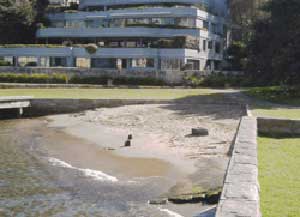
A tiny triangle of beach on Lavender Bay in Sydney, NSW, is the smallest registered beach in the whole of Australia. The beach once extend the full length of the bay’s foreshore, but industry and then the development of wharves, boat moorings and seawalls has seen it shrink to its present miniscule size.
 Surrounded by bleak, treeless plains, Betoota in western Qld is not only Australia’s smallest town, it is believed to be the only town in the world with a population of zero. Its sole resident of 49 years retired in 1997, age 82. Situated on a rough dirt road between Windorah and Birdsville, its only structure is an abandoned hotel. Betoota is an officially designated town, complete with a town plan and a subdivision. The Birdsville-based Diamantina Shire Council recently put some blocks up for sale in Betoota for between $200 and $500 each. To the surprise of everyone, six were sold.
Surrounded by bleak, treeless plains, Betoota in western Qld is not only Australia’s smallest town, it is believed to be the only town in the world with a population of zero. Its sole resident of 49 years retired in 1997, age 82. Situated on a rough dirt road between Windorah and Birdsville, its only structure is an abandoned hotel. Betoota is an officially designated town, complete with a town plan and a subdivision. The Birdsville-based Diamantina Shire Council recently put some blocks up for sale in Betoota for between $200 and $500 each. To the surprise of everyone, six were sold.

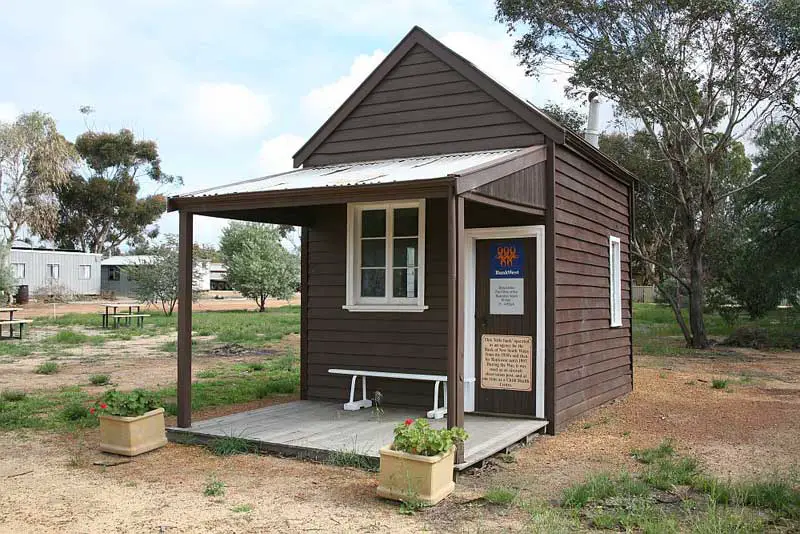
The town of Shackleton in the Western Australian Wheatbelt claims to have Australia’s smallest bank. Measuring only 3 metres by 4 metres it is only open on Fridays from 3.00 pm – 4.30 pm.
 Victoria is Australia’s smallest mainland state (228,000 square kilometres) and is slightly smaller than the US state of California, but about the same size as the the US state of Minnesota or the United Kingdom.
Victoria is Australia’s smallest mainland state (228,000 square kilometres) and is slightly smaller than the US state of California, but about the same size as the the US state of Minnesota or the United Kingdom.
Last
The last tram ran in Sydney on 26th February 1961. Convict William Bond is believed to have been the last male alive from the First Fleet. Bond, who became a baker of Pitt Street, Sydney, NSW, made the first damper. Bond died in Sydney in 1839, aged 110 years.
Convict William Bond is believed to have been the last male alive from the First Fleet. Bond, who became a baker of Pitt Street, Sydney, NSW, made the first damper. Bond died in Sydney in 1839, aged 110 years.
 Ann Huxley (nee Forbes), who was transported on Prince of Wales at 15 years of age for stealing 10 yards of material, was the very last of the convicts of the First Fleet to die. She had been sent to Norfolk Island before she was freed. After several liaisons she went on to marry Thomas Huxley and settled near Windsor, where she raised nine children to Huxley and four to Dringad Bannister. She died in 1851, age 80, and was buried in St Matthews Church graveyard, Windsor, NSW.
Ann Huxley (nee Forbes), who was transported on Prince of Wales at 15 years of age for stealing 10 yards of material, was the very last of the convicts of the First Fleet to die. She had been sent to Norfolk Island before she was freed. After several liaisons she went on to marry Thomas Huxley and settled near Windsor, where she raised nine children to Huxley and four to Dringad Bannister. She died in 1851, age 80, and was buried in St Matthews Church graveyard, Windsor, NSW.

Fastest
Ken Warby’s hydroplane, Spirit of Australia, is the fastest boat in the world. Spirit of Australia set the World Water Speed Record in 1978; remarkably the boat still holds that record. It is on display at the Australian National Maritime Museum.
Narrowest
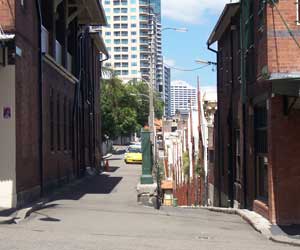
At 2.4 metres from kerb to kerb, Sydney’s narrowest street is Argyle Lane in Millers Point (right). High Lane, which runs parallel to Argyle Lane, is just 8 cm wider but is on a higher elevation in its middle section. The two streets appear to be dual carriageways of the same street but they are not.

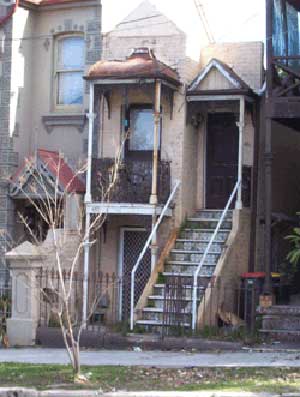
The narrowest house in Sydney and possibly the whole of Australia is a tiny, two storied Victorian house at 43a Edgeware Road, Enmore. It is just 3 metres wide. In spite of its size, it was subdivided at one stage into 4 flats. Steep stairs in a blue and white pattern lead to the front door. The tiny verandah is heavily decorated with cast-iron lace.
Wettest
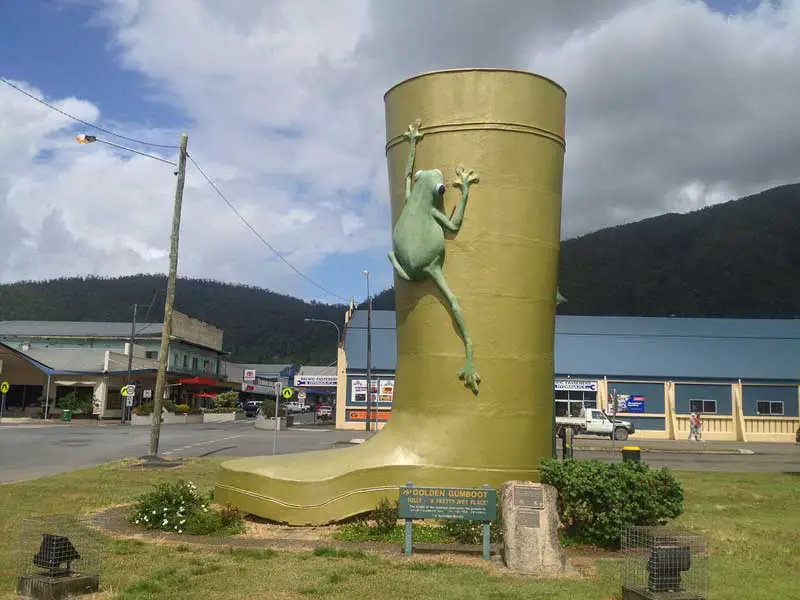
Tully, Qld, is the wettest town in Australia with an average annual rainfall of 355.6 centimetres (11 ft, 10 inches). It is appropriate that the town’s symbol is a giant gumboot.
Tallest
The Ferguson Tree, near Healesville, Watts River Catchment, Victoria, was not only the tallest tree ever measured in Australia but ever measured in the world. Surveyor Ferguson measured it in 1872 at over 500 ft (154m+), with a girth of 56.5ft (17.5m). The fallen tree was measured at 435 feet however the top had broken off in the fall. The broken top section was measured at 66 feet. Giant Swamp Gums in the Styx Valley Tall Tree reserve in Tasmania’s Mt Field National Park are up to 87 metres tall and are believed to be the tallest hardwood trees on earth.
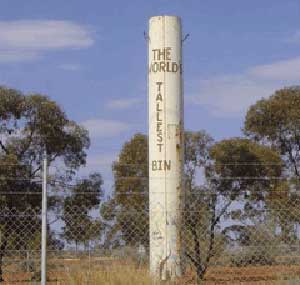
The world’s tallest rubbish bin is at Kalgoorlie, WA. It is rarely used as few people are tall enough to use it!
 Australia’s highest single drop waterfall is Wallaman Falls, Qld. West of Ingham, Stony Creek plunges off the Seaview Range in a single plunge of more than 268 metres down a sheer cliff. With additional related minor drops, the overall height of the falls is approximately 340 metres. The pool at the end of the waterfall is 20 metres deep.
Australia’s highest single drop waterfall is Wallaman Falls, Qld. West of Ingham, Stony Creek plunges off the Seaview Range in a single plunge of more than 268 metres down a sheer cliff. With additional related minor drops, the overall height of the falls is approximately 340 metres. The pool at the end of the waterfall is 20 metres deep.

 Q1 (meaning Queensland Number One), a skyscraper located in Surfers Paradise, on the Gold Coast, is the world’s tallest residential tower and the tallest building in Australia and the Southern Hemisphere. At a height of 322.5 metres, it is 13.5 metres taller than Sydney tower.
Q1 (meaning Queensland Number One), a skyscraper located in Surfers Paradise, on the Gold Coast, is the world’s tallest residential tower and the tallest building in Australia and the Southern Hemisphere. At a height of 322.5 metres, it is 13.5 metres taller than Sydney tower.
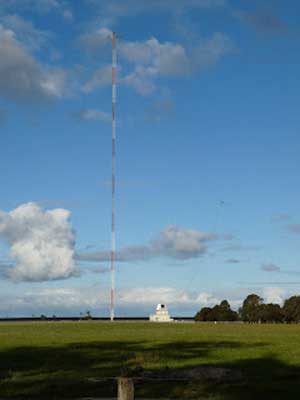
The tallest structure in Australia and in fact the southern hemisphere is the mast of the Woodside Omega Transmitter (station G, now Woodside VLF transmitter) near Woodside, Victoria. It uses an umbrella antenna carried by a 432 metre high grounded lattice steel guyed mast. After the shutdown of OMEGA it was used until 2004 as transmitter for orders to submarines on 13 kHz. Today it works on 18.6 kHz.
At 387 metres, the second tallest is Tower Zero at the Harold E. Holt Naval Communication Station at Exmouth in WA. The station provides very low frequency (VLF) radio transmission to United States Navy and Royal Australian Navy ships and submarines in the western Pacific Ocean and eastern Indian Ocean. With a transmission power of 1000 kilowatts, it is the most powerful transmission station in the Southern hemisphere. Tower zero is surrounded by 12 lesser towers. Six of the lesser towers stand 364 metres high, making them the equal third tallest made made structures in Australia.
Most
The most densely populated area in Australia is the Sydney suburb of Elizabeth Bay.
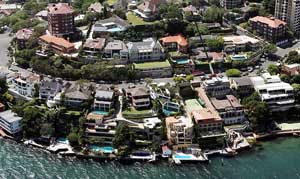
The most valuable street in Australia in terms of its real estate value has been calculated as being Wolseley Road in the Sydney suburb of Point Piper. An evaluation in 2002 calculated the total value of waterfront properties in this 1 km long blue-ribbon street as being $720 million. In April 2008, the median property price was $7,092,000.
Least
Lake Eyre, SA, has the least recorded average rainfall of any locality in Australia. It receives an average of 125 mm per year.Oldest
The oldest daily newspaper in the southern hemisphere is the Sydney Morning Herald (1831). Sofala, the NSW Central West, is Australia’s oldest surviving goldrush town.
Sofala, the NSW Central West, is Australia’s oldest surviving goldrush town.
 Tharwa is the oldest official settlement in the Australian Capital Territory, proclaimed a settlement in 1862. Tharwa was named after the Aboriginal word for Mount Tennent, the overlooking mountain which is part of Namadgi National Park.
Tharwa is the oldest official settlement in the Australian Capital Territory, proclaimed a settlement in 1862. Tharwa was named after the Aboriginal word for Mount Tennent, the overlooking mountain which is part of Namadgi National Park.

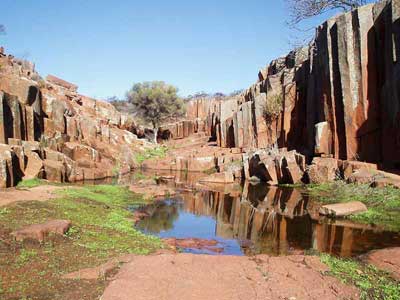
The Gawler Ranges landscape is believed to be one of the oldest, if not the oldest landscapes on Earth. They consist of rock formed from ash spewed out by massive volcanic eruptions almost 1600 million years ago.
 Embedded into the shore rocks and visible at low tide at Fossil Bluff near Wynyard, Tas, are Australia’s oldest marsupial fossils.
Embedded into the shore rocks and visible at low tide at Fossil Bluff near Wynyard, Tas, are Australia’s oldest marsupial fossils.
 The oldest skeleton found in Australia was at Lake Mungo, NSW. It is believed to be 38,000 years old and is the skeleton of a female.
The oldest skeleton found in Australia was at Lake Mungo, NSW. It is believed to be 38,000 years old and is the skeleton of a female.
 No. 40 Macquarie Street, Hobart, Tas is the oldest continuously occupied building in Australia. It is now part of the Tasmanian Museum and Art Gallery.
No. 40 Macquarie Street, Hobart, Tas is the oldest continuously occupied building in Australia. It is now part of the Tasmanian Museum and Art Gallery.
 Erected in 1815, The Bush Inn at New Norfolk, Tas, is Australia’s oldest continuously licensed Hotel.
Erected in 1815, The Bush Inn at New Norfolk, Tas, is Australia’s oldest continuously licensed Hotel.

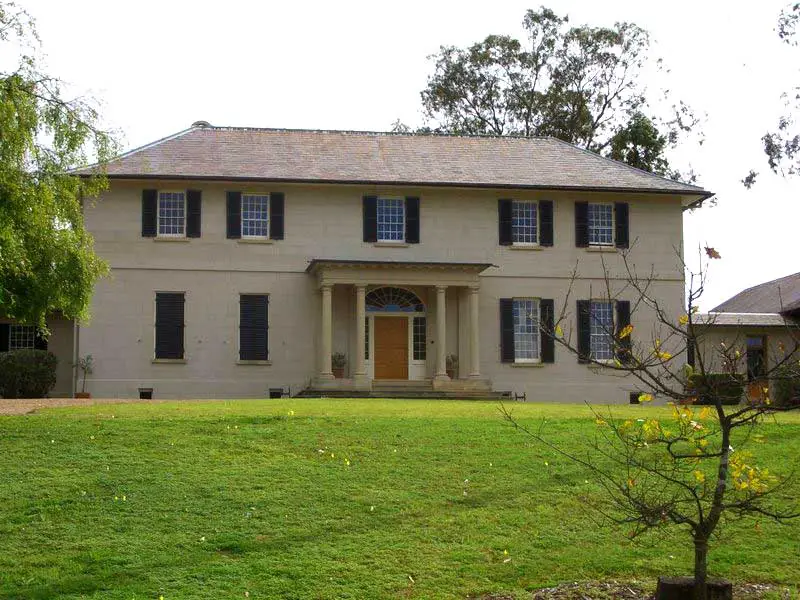
Old Government House in Parramatta, NSW, is Australia’s oldest public building. The original was built for Arthur Phillip in 1790. Much of Phillip’s building had collapsed in 1799 when Governor Hunter replaced it with the Georgian structure present today.
 Australia’s oldest European dwelling to the south of Sydney is situated on Preservation Island, in the Bass Strait. The structure is part of the survivor camp from the merchant ship Sydney Cove which was wrecked on the island in 1797.
Australia’s oldest European dwelling to the south of Sydney is situated on Preservation Island, in the Bass Strait. The structure is part of the survivor camp from the merchant ship Sydney Cove which was wrecked on the island in 1797.

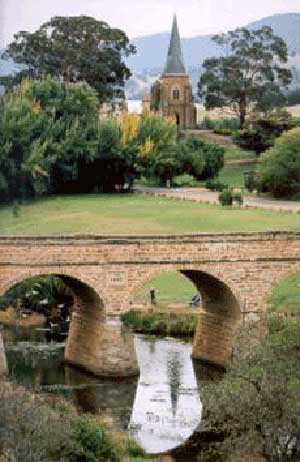
Richmond Bridge, over the Cole River, Tas, is the oldest bridge in Australia. It was built by convicts in 1823.
 Elizabeth Farm at Harris Park near Parramatta, NSW, is the oldest surviving European building in Australia. commenced in 1793, it was built as the home of John and Elizabeth Macarthur.
Elizabeth Farm at Harris Park near Parramatta, NSW, is the oldest surviving European building in Australia. commenced in 1793, it was built as the home of John and Elizabeth Macarthur.
 Australia’s oldest church is the Presbyterian Church at Ebenezer, NSW. The church was built by public subscription in the early 1800s.
Australia’s oldest church is the Presbyterian Church at Ebenezer, NSW. The church was built by public subscription in the early 1800s.
 The site of Australia’s first colonial burial ground at Dawes Point, Sydney, NSW
The site of Australia’s first colonial burial ground at Dawes Point, Sydney, NSW
 Australia’s oldest existing gravestone was erected in an area known as Campbell’s Ridge at Dawes Point which was Sydney’s first burial ground. Its inscription reads: “In memory of George Graves late boatswain’s yeoman of H.M.S. Sirius who departed this life ye 10th July 178(8) aged 48 years”. The headstone was dug out of the ground in the early 1870s and later found serving as a paving stone in The Rocks. The stone is now on display in the Coach House at Vaucluse House.
Australia’s oldest existing gravestone was erected in an area known as Campbell’s Ridge at Dawes Point which was Sydney’s first burial ground. Its inscription reads: “In memory of George Graves late boatswain’s yeoman of H.M.S. Sirius who departed this life ye 10th July 178(8) aged 48 years”. The headstone was dug out of the ground in the early 1870s and later found serving as a paving stone in The Rocks. The stone is now on display in the Coach House at Vaucluse House.
 The Royal Botanic Gardens, Sydney, is the oldest scientific institution and the oldest Garden in Australia.
The Royal Botanic Gardens, Sydney, is the oldest scientific institution and the oldest Garden in Australia.
 The oldest known undisturbed marked grave in Australia is in St John’s Cemetery, Parramatta, NSW. A slab of river sandstone bears the simple inscription: “H.E. Dodd 1791.” He was buried there on 29th January 1791, a year after the opening of the cemetery. Dodd was Gov. Phillip’s valet for the voyage out from England.
The oldest known undisturbed marked grave in Australia is in St John’s Cemetery, Parramatta, NSW. A slab of river sandstone bears the simple inscription: “H.E. Dodd 1791.” He was buried there on 29th January 1791, a year after the opening of the cemetery. Dodd was Gov. Phillip’s valet for the voyage out from England.
 Bridestowe Lavender Farm at Nabowla in north eastern Tasmania, is the oldest and largest lavender plantation in the world.
Bridestowe Lavender Farm at Nabowla in north eastern Tasmania, is the oldest and largest lavender plantation in the world.
 Belgenny Farm, near Camden, NSW, is the oldest continuously working farm and oldest pastoral sheep stud in Australia.
Belgenny Farm, near Camden, NSW, is the oldest continuously working farm and oldest pastoral sheep stud in Australia.
 Founded in 1837 The King’s School at Parramatta, NSW, is the oldest independent school in Australia.
Founded in 1837 The King’s School at Parramatta, NSW, is the oldest independent school in Australia.

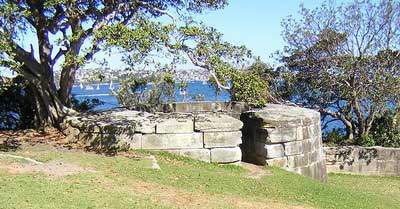
Bradleys Head on Sydney Harbour is Australia’s oldest defence site. Sections of a sandstone firing wall at the location date from 1802.
 Royal National Park, in Sydney’s south, is Australia’s oldest and the world’s second-oldest, national park after Yellowstone Park in the USA. On 26th April 1879, just under 7000 hectares of land on the fringes of Sutherland Shire was proclaimed ‘The National Park’
Royal National Park, in Sydney’s south, is Australia’s oldest and the world’s second-oldest, national park after Yellowstone Park in the USA. On 26th April 1879, just under 7000 hectares of land on the fringes of Sutherland Shire was proclaimed ‘The National Park’
 Who killed the first Aboriginal resistance leader, Pemulwuy, is Australia’s oldest murder mystery. The identity of the legendary Aboriginal warrior’s murderer has remained a mystery for 200 years. It is now believed that Pemulwuy’s killer was Henry Hacking, a violent man and a heavy drinker who had been quartermaster of HMS Sirius, the First Fleet’s flagship. Hacking was possibly the first colonist to shoot and wound an indigenous person in Australia.
Who killed the first Aboriginal resistance leader, Pemulwuy, is Australia’s oldest murder mystery. The identity of the legendary Aboriginal warrior’s murderer has remained a mystery for 200 years. It is now believed that Pemulwuy’s killer was Henry Hacking, a violent man and a heavy drinker who had been quartermaster of HMS Sirius, the First Fleet’s flagship. Hacking was possibly the first colonist to shoot and wound an indigenous person in Australia.

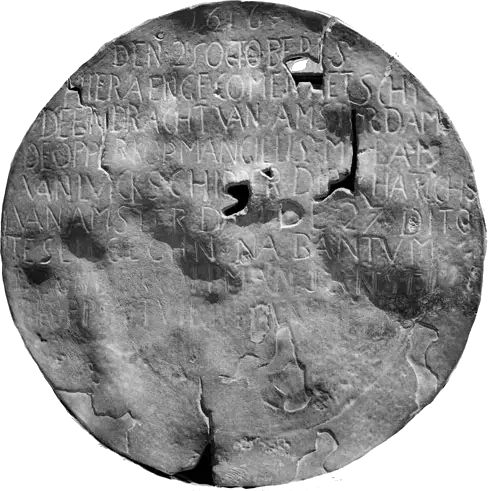
Australia’s oldest European artifact is the Hartog plate, a pewter dinner plate which Dutch navigator Dirk Hartog had engraved and mounted on a post at Shark Bay, WA, to record his visit there in 1616. It remained there for a remarkable 81 years until it was replaced with a similar one by fellow Dutchan Willam de Vlamingh. Hartog’s plate is now in the possession of the Rijksmuseum in Amsterdam, The Netherlands.
 Located on the Hunter River, NSW, Wyndham Estate was established in 1828 by George Wyndham and is Australia’s oldest operating winery. Yalumba, in South Australia’s Barossa Valley, is Australia’s oldest family-owned winery.
Located on the Hunter River, NSW, Wyndham Estate was established in 1828 by George Wyndham and is Australia’s oldest operating winery. Yalumba, in South Australia’s Barossa Valley, is Australia’s oldest family-owned winery.
 The Perth Mint was established in 1899 making it Australia’s oldest mint still in operation. Its original purpose was to make gold sovereigns for the British Empire from gold extracted from WA’s eastern goldfields.
The Perth Mint was established in 1899 making it Australia’s oldest mint still in operation. Its original purpose was to make gold sovereigns for the British Empire from gold extracted from WA’s eastern goldfields.
 Australia’s oldest public fountain is the John Baptist Fountain, which is situated in Australia’s oldest park, Hyde Park, in the heart of Sydney, NSW.
Australia’s oldest public fountain is the John Baptist Fountain, which is situated in Australia’s oldest park, Hyde Park, in the heart of Sydney, NSW.

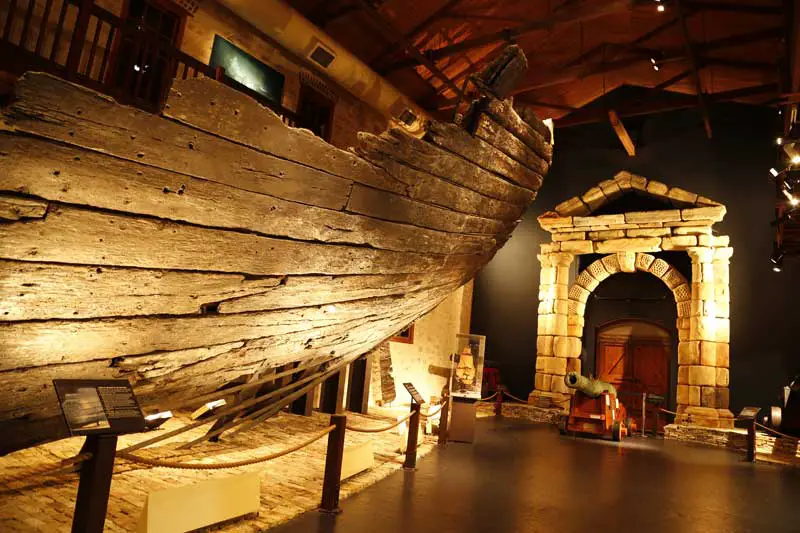
Research work on timbers from the Dutch ship Batavia show that it was built from the same oak on which famous Flemish artists such as Rembrandt and Rubens painted their 17th century masterpieces. Tree-ring dating shows that Australia’s oldest ship timbers date back to seedlings growing in a Polish oak forest south of Danzig after 1324. In 1628, they were used to build the Batavia, which sank off Geraldton WA, in 1629 on its maiden voyage to Indonesia. By the time the ship was built in 1628, the wood beams sourced from the forests growing along Poland’s longest river was already 300 years old – making the ship’s timbers some of the oldest splinters in maritime history.
 Australia’s oldest brewery, Cascade, was established in its photogenic location on the southwestern edge of the city of Hobart, Tas, in 1832.
Australia’s oldest brewery, Cascade, was established in its photogenic location on the southwestern edge of the city of Hobart, Tas, in 1832.
 The Theatre Royal in Hobart, Tas, Australia’s oldest continually operating theatre.
The Theatre Royal in Hobart, Tas, Australia’s oldest continually operating theatre.
 Ratho, at Bothwell in the Tasmanian midlands, is the oldest golf course in Australia. Scottish settlers brought the game of golf to Tasmania in the 1820s when they settled there. They laid out the course on their sheep property and the square-shaped greens were fenced to keep the sheep out.
Ratho, at Bothwell in the Tasmanian midlands, is the oldest golf course in Australia. Scottish settlers brought the game of golf to Tasmania in the 1820s when they settled there. They laid out the course on their sheep property and the square-shaped greens were fenced to keep the sheep out.

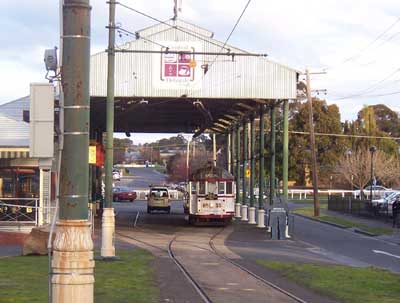
Australia’s oldest operating tram depot is in Bendigo, Vic. Situated in Violet Street, it is home to Bendigo Tramways and its 32 vintage trams from Melbourne and Bendigo.
 Perth Observatory is Australia’s oldest continuously operating professional observatory and Western Australia’s premier astronomical institution. Located 25km east of Perth, the Observatory has served the state of WA for over 100 years.
Perth Observatory is Australia’s oldest continuously operating professional observatory and Western Australia’s premier astronomical institution. Located 25km east of Perth, the Observatory has served the state of WA for over 100 years.
 The Low Head pilot and signal station at Low Head (Georgetown) Tas is Australia’s oldest continuously used pilot station. First ommissioned in 1805, its current buildings date from 1838.
The Low Head pilot and signal station at Low Head (Georgetown) Tas is Australia’s oldest continuously used pilot station. First ommissioned in 1805, its current buildings date from 1838.
 Hahndorf, in the Adelaide Hills, SA, is Australia’s oldest surviving German settlement.
Hahndorf, in the Adelaide Hills, SA, is Australia’s oldest surviving German settlement.
 Established in 1917, Queensland-based Morgan & Wacker is the world’s oldest Harley-Davidson Dealership outside the USA, and Australia’s oldest Motorcycle dealer for any brand of bike.
Established in 1917, Queensland-based Morgan & Wacker is the world’s oldest Harley-Davidson Dealership outside the USA, and Australia’s oldest Motorcycle dealer for any brand of bike.
 Birchalls has the distinction of being Australia’s oldest bookshop. It opened for business in November 1844 in Launceston, Tas, on its current site as a seller of “books, stationery and fancy goods”.
Birchalls has the distinction of being Australia’s oldest bookshop. It opened for business in November 1844 in Launceston, Tas, on its current site as a seller of “books, stationery and fancy goods”.
 Hobart Synagogue in Argyle Street is Australia’s oldest synagogue. Erected 1843-45, the single storey building was designed by James Thomson. It is a rare example of Regency Egyptian Revival style.
Hobart Synagogue in Argyle Street is Australia’s oldest synagogue. Erected 1843-45, the single storey building was designed by James Thomson. It is a rare example of Regency Egyptian Revival style.
Geographical Extemities
Most Northerly Point: The tip of Cape York Peninsula in far-north Queensland.
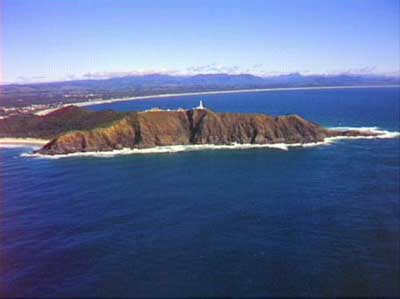
Cape Byron
Most Easterly Point: Cape Byron, two kilometres east of Byron Bay, in northern New South Wales
Most Southerly Point (mainland): South Point at the tip of Wilson’s Promontory, Victoria.
Most Southerly Point (incl. Tasmania): South East Cape, Tasmania.
Most Westerly Point: Steep Point, a short distance from Shark Bay, between Dirk Hartog Island and Useless Loop in Western Australia.
Lowest Point (surface): Lake Eyre, which is 16 metres below sea level.
Lowest Point (underground): Australia’s deepest cave is Anne-A-Kananda of Mt Anne, Tas. It goes 373 metres below surface level.
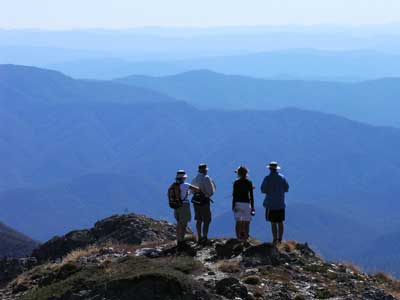
Mt Kosciuszko
Highest Point (mainland): Mt Kosciuszko, 2,228 metres above sea level.
Highest Point: Mawsons Peak, which is 2,745 metres above sea level. Located on Heard Island, Australian Antarctic Territory.
